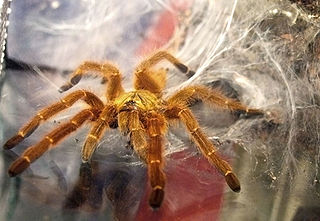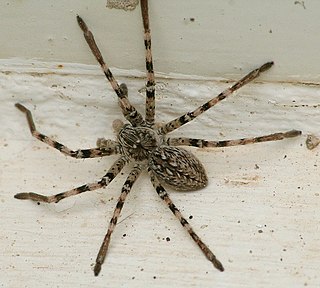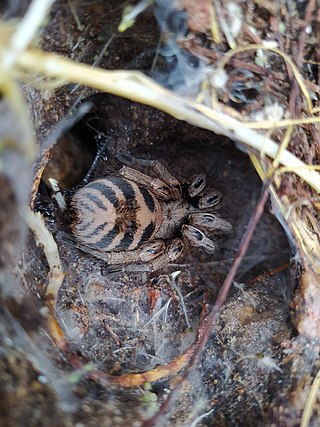
The Kalahari Desert is a large semi-arid sandy savanna in Southern Africa extending for 900,000 square kilometres (350,000 sq mi), covering much of Botswana, as well as parts of Namibia and South Africa.

The cephalothorax, also called prosoma in some groups, is a tagma of various arthropods, comprising the head and the thorax fused together, as distinct from the abdomen behind.. The word cephalothorax is derived from the Greek words for head and thorax. This fusion of the head and thorax is seen in chelicerates and crustaceans; in other groups, such as the Hexapoda, the head remains free of the thorax. In horseshoe crabs and many crustaceans, a hard shell called the carapace covers the cephalothorax.

Brachypelma hamorii is a species of tarantula found in Mexico. It has been confused with B. smithi; both have been called Mexican redknee tarantulas. Many earlier sources referring to B. smithi either do not distinguish between the two species or relate to B. hamorii. B. hamorii is a terrestrial tarantula native to the western faces of the Sierra Madre Occidental and Sierra Madre del Sur mountain ranges in the Mexican states of Colima, Jalisco, and Michoacán. The species is a large spider, adult females having a total body length over 50 mm (2 in) and males having legs up to 75 mm (3 in) long. Mexican redknee tarantulas are a popular choice for enthusiasts. Like most tarantulas, it has a long lifespan.

Brachypelma smithi is a species of spider in the family Theraphosidae (tarantulas) native to Mexico. It has been confused with Brachypelma hamorii; both have been called Mexican redknee tarantulas. Mexican redknee tarantulas are a popular choice as pets among tarantula keepers. Many earlier sources referring to B. smithi either relate to B. hamorii or do not distinguish between the two species. B. smithi is a terrestrial tarantula native to Pacific coast of the Mexican state of Guerrero.

The Harpactirinae are a subfamily of tarantulas which are native to the continent of Africa. Like many Old World tarantulas, they have a relatively strong venom and can inflict a painful bite.

Pterinochilus is a genus of baboon spiders that was first described by Reginald Innes Pocock in 1897. They are found all throughout Africa

Ceratogyrus is a genus of tarantulas found in southern Africa. They are commonly called horned baboons for the foveal horn found on the peltidium in some species.

The skeleton tarantula, Ephebopus murinus, is a species of spider belonging to the family Theraphosidae (tarantulas), sub-family Aviculariinae. A New World species, it is native to several South American countries. Its common name is derived from the skeleton-like markings on its legs.

Eusparassus is a genus of huntsman spiders, known as the stone huntsman spiders, it was first described by Eugène Louis Simon in 1903.

Hydnora triceps is a holoparasitic flowering plant native to Africa that grows on the roots of Euphorbia dregeana. Completely lacking in chlorophyll, it depends on its host for water and nutrients. The plant structure is composed of only specialized stems, buds, and haustoria, lacking any leaf-like structures entirely. It spends its life underground and only emerges to flower.

Ephebopus cyanognathus, known as the blue fang tarantula, is a species of tarantula. It is endemic to French Guiana. It was first described by Rick C. West and Samuel D Marshall in 2000, and is somewhat commonly kept as pets. As it common name may suggest, they have magnificent blue chelicerae, cyano meaning blue and gnathus meaning jaw. This tarantula is a burrowing spider, though spiderlings of this species have been observed to be semi-arboreal.
Augacephalus is a genus of harpacterine theraphosid spiders. It has three species, all of which are found in Africa.
Cardiopelma is a genus of spiders in the family Theraphosidae. It was first described in 1999 by Vol. As of 2017, it contains only one species, Cardiopelma mascatum, known only from Mexico, in the state of Oaxaca.

Encyocratella is a monotypic genus of Tanzanian tarantulas containing the single species, Encyocratella olivacea, also known as the Tanzanian black and olive baboon spider. It was first described by Embrik Strand in 1907, and is found in Tanzania.

Harpactira pulchripes, also known as the golden blue-legged baboon spider, is a bright yellow-bodied and metallic blue-legged tarantula found in South Africa. It was first described by Reginald Innes Pocock in 1901. It is a very highly desired tarantula in the European and American tarantula keeping hobby. Its specific name pulchripes is derived from Latin "pulchri" meaning beautiful, and "pes" meaning feet, forming the name beautiful feet.
Bumba tapajos is a tarantula in the genus Bumba. It was first described by Lucas, Passanha and Brescovit in 2020. The species is named after where it was found, in the Tapajós area in Brazil.
Pterinochilus lugardi also known Grey starburst baboon, Dodoma baboon, Fort hall baboon or Tanzanian blonde baboon tarantula is a tarantula first described by Reginald Innes Pocock in 1900. They are found all over Southern and Eastern Africa, of course excluding Madagascar.
Eucratoscelus pachypus also known as the Tanzania stout leg baboon tarantula or the stout leg tarantula, was first described by Gunter Schmidt and Volker von Wirth in 1990. It is found in Tanzania, hailing from arid parts, and is an obligate burrower.

Anqasha is a monotypic genus of Peruvian tarantulas, containing one species, Anqasha picta, first described by Danniella Sherwood and Ray Gabriel in 2022. The type species was initially described under the name Hapalopus pictus in 1903 by Reginald Innes Pocock, but was later moved to the Homoeomma genus, until finally becoming Anqasha. Its name comes from the Quechuan word for blue, "anqash".
Murphyarachne is a monotypic genus of Peruvian tarantulas, with one species, Murphyarachne ymasumacae. It was first described by Sherwood and Gabriel in 2022. The genus is named after Frances Mary Murphy and John Alan Murphy for their contributions to arachnology, and the Greek term "arachne", which is the word for spider.












